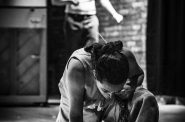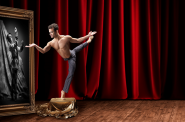David Parsons, vibrant dance in Brookfield
David Parsons Dance, one of the world's great companies, set the crowd to cheering Saturday at the Sharon Lynne Wilson Center.
David Parsons’ Round My World is a perfect world of dancers in harmonious play with gravity, Zoe Keating’s music and one another. In this new work, seen Saturday in a thrilling Parsons Dance program at the Sharon Lynne Wilson Center, Parsons devised patterns and partnering, for six couples, that amount to a sunlit Newtonian civilization.
Wheels within wheels, themselves often made of spinning bodies, form and reform in the blink of an eye. The great fleetness, without a hint of haste or strain, dazzles the eye. Christina Ilisije, Melissa Ullom and Elena D’Amario stepped into the air and the arms of Eric Bourne, Steven Vaughn and Ian Spring and spun about them like moons. The women wear sundresses and the men jeans the exact color of earthly seas viewed from space. Parson’s little planet not only teems with life, but life full of grace and courtesy.
The men and women merge like two liquids with a natural attraction, with no sense of push, pull, conflict or, in the aerial lifts, danger. The relations of the men and women are sensual in the senses of proximity and joyous shared athleticism. They are effortlessly precise and sure of ensemble timing and partner support. They hold their bodies lightly but firmly, as impetus rises from the hips and flows out through the limbs.
Circle motifs permeate Round My World, from the opening round dance to the frequent formations of O’s with the arms. Arms thus held swoop through patterns of bends and turns. Often those arms encircle partners and sweep down head to toe, a touching gesture of affection. Parsons adds material to each of the four movements while carrying something over from the prior one. Thus the piece accumulates mass and meaning — but not weight. The glowing lightness holds through the end, when the men hold aloft the women, connected hand to toe, as the men circle beneath them to turn as a human carousel.
Parsons’ endlessly inventive wit shone especially in Hand Dance (2oo3), in which a narrow band of light leaves all black except for five sets of arms and hands. The limbs swept gracefully as the fiddler limned melodies, or twittered or pounded along with the honky tonk piano in Kenji Bunch’s country-jazz score.
In Swing Shift (2003), for eight dancers, Parsons again posits the ensemble as a community. Melissa Ullom solos in a cone of light to the Prelude of Kenji Bunch’s Swing Shift suite. The ensemble enters and gradually sweeps the loner into the swing of Parsons very sophisticated take on swing dancing.
Thrust and force are more marked than in Round My World. Every now and then, Swing Shift looks just a little like ballroom Lindy. Parsons retains the enormous, joyous energy of the ballroom style but channels into even more virtuosic moves contained within complex structures and related to a wisp of narrative. Ullom, once converted, becomes the most fervent swing believer, until she strays at the very end. In a poignant duet in the middle, Elena D’Amario pulls her man, Eric Bourne, away from the group. In both cases, the strays succumb to the irresistible attraction of the group.
Caught (1982), Parson’s signature piece, brought down the house. It always does. Through the miracle of perfectly timed jumps combined with strobe lighting, plus the lift of Robert Fripp’s terrifying Let the Power Fall, makes it appear that a man can fly. Caught is not only a lighting trick, but also a great athletic feat. Steven Vaughan pulled it off with great panache Saturday.
Jeans and tees set the mood of In the End (2005), to a suite of Dave Matthews Band songs. The eight dancers looked like Gap kids and acted on that vibe in the first couple of numbers, utterly charming glosses on rock ‘n’ roll dancing that made you feel the kids are all right. But the mood darkened for Matthews’ When the World Ends, and Bourne, Ullom and Ilisije took turns as fiery preachers before their arrayed, wide-eyed colleagues. The soloists made their points with furious, relentless, bone-jarring, trembling solos that left it all on the playing field.
To see what else is coming to the Sharon Lynne Wilson Center, visit the center’s website. To know what’s going on everywhere, bookmark Matthew Reddin’s TCD Guide to 2012-13 and check Danielle McClune’s On Stage column every week (it publishes Tuesday).
Display photo on Arts and Culture page: David Parsons’ “Hand Dance.” David Kielpinski photo for Parsons Dance.
Dance
-
New Riverwest Company, Production Impresses
 Feb 10th, 2020 by Brendan Fox
Feb 10th, 2020 by Brendan Fox
-
Milwaukee Ballet Show Remakes History
 Feb 10th, 2020 by Catherine Jozwik
Feb 10th, 2020 by Catherine Jozwik
-
Ballet Does Free Production of ‘Nutcracker’
 Dec 20th, 2019 by Richard Davis
Dec 20th, 2019 by Richard Davis





















